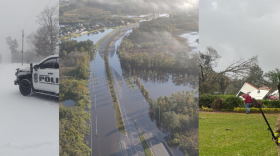Marine scientists with the Sanibel-Captiva Conservation Foundation are updating its crucial water-quality monitoring system in Southwest Florida for the first time since its launch in 2007.
The SCCF’s marine lab is busy installing a new generation of sensors in their “river, estuary, and coastal observing network,” which they dubbed “RECON.”
“ ‘Recon’ has been a real game-changer for our region,” James Evans, SCCF’s environmental policy director, said. “Without its 24-7 data output on nutrients, dissolved oxygen, algae blooms, turbidity, and other indicators of our regional water quality, it would be impossible to advocate for science-based water management policies and regulations.”
The system is a network of eight optical water-quality sensors deployed throughout the Caloosahatchee and the Pine Island Sound estuary that provide real-time water quality data to scientists, policymakers, and the public through a free website.
A widespread blue-green algae bloom in the Caloosahatchee in 2018 showed its devastating potential, and highlighted the problems with a lack of continuous monitoring in the watershed.
SCCF recently received taxpayer grants through the Environmental Protection Agency and the Army Corps of Engineers to establish two additional water-monitoring stations in the Caloosahatchee River.
In addition to standard water quality data, the new stations will have a sensor that measures phycocyanin, a blue pigment found in cyanobacteria, which is almost synonymous with blue-green algae. It will help scientists understand past events and the conditions that cause algae blooms.
Groups like the SCCF monitor the region’s waterways for algal blooms, and when they discover a bloom is forming, they warn the public, and give researchers time to get to the area to study the phenomena.
The lab has partially upgraded four of their seven sites and are currently working on the other three.
When it first went online, the monitoring network was given an estimated life span of seven years by the sensors’ manufacturer. Through an exacting maintenance program SCCF scientists were able to double the lifespan of the network before the new equipment arrived.
“Assuming testing of the new sensors goes smoothly, we hope to have the new sites running by mid-August,” said A.J. Martignette, manager of SCCF’s marine lab. “After that, we will finish upgrading the rest of the network, starting with the four partially upgraded ones.”
For more about the monitoring network here.
Environmental reporting for WGCU is sponsored in part by the VoLo Foundation, whose mission is to accelerate change and global impact by supporting science-based climate solutions, enhancing education, and improving health.








